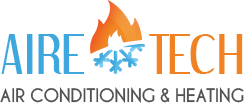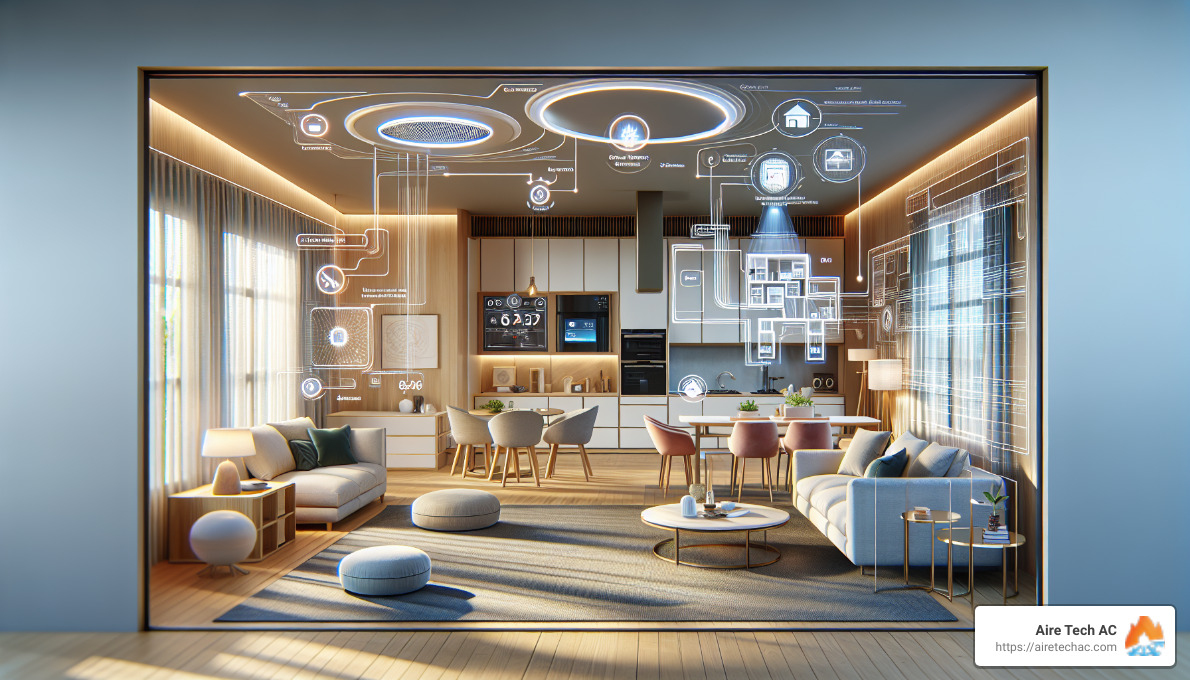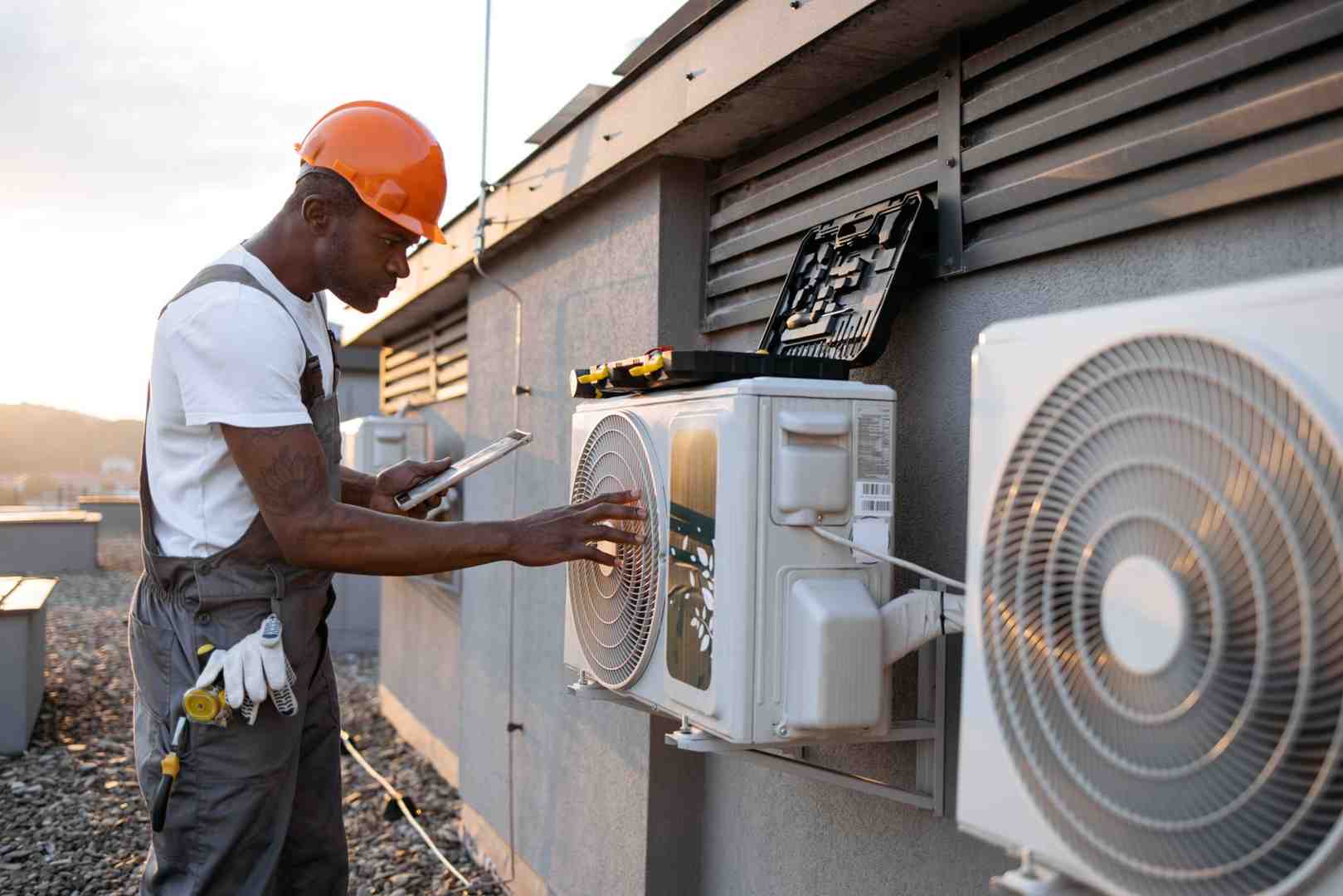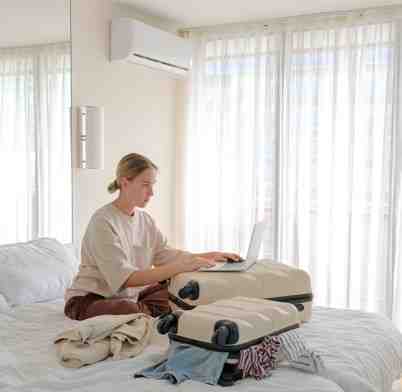Smart home ventilation systems are revolutionizing the way we manage air quality and comfort in our homes. By integrating advanced HVAC systems with smart technology, these systems offer efficient, remote control over your home’s ventilation, heating, and air conditioning. Here’s a quick overview:
- Improved Air Quality: Smart home ventilation systems ensure that the air inside your home is free from pollutants, allergens, and moisture.
- Energy Efficiency: Tailoring ventilation based on room usage and air quality reduces energy consumption and lowers utility bills.
- Comfort and Convenience: Automated systems adjust air flow and temperature to keep every room at your preferred comfort level.
Why is smart home ventilation important?
In today’s airtight homes, proper ventilation is crucial for maintaining healthy indoor air quality. High humidity and poor air circulation can lead to mold, mildew, and even structural damage. A smart home ventilation system not only expels stale, humid air but also brings in filtered, fresh air, creating a healthier environment for your family.
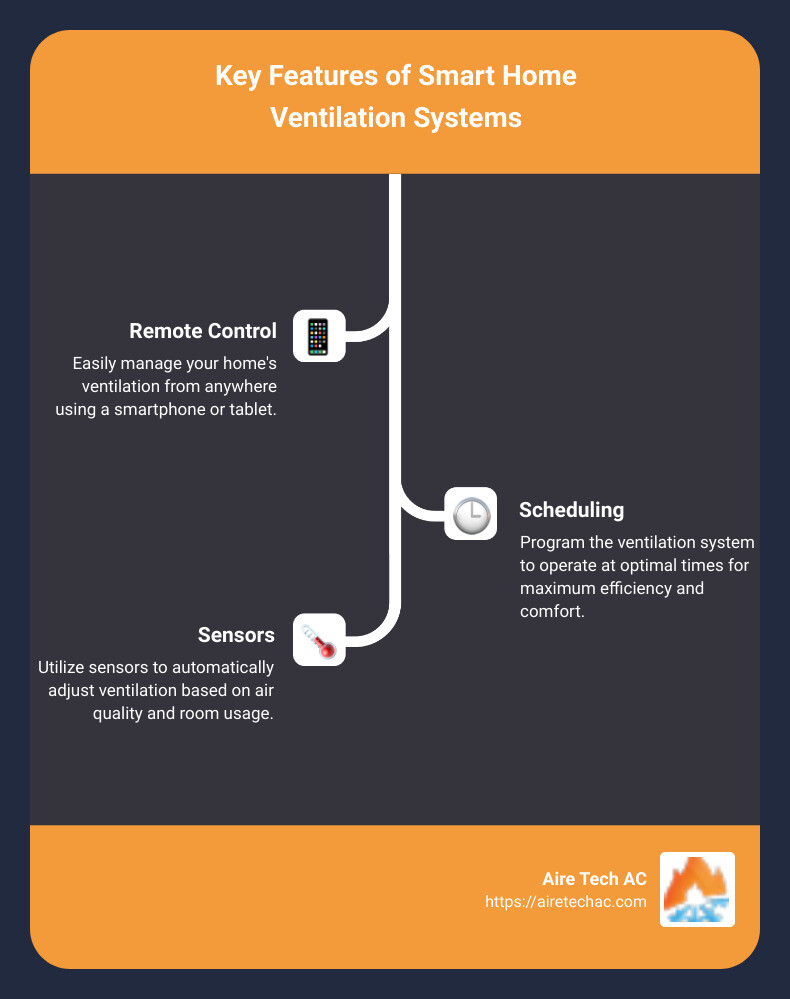
What is Smart Home Ventilation?
Smart home ventilation systems are designed to improve the air quality inside your home by using advanced technology to monitor and control airflow. These systems are part of the broader smart home ecosystem, which includes devices like smart thermostats, lights, and security systems. They offer a seamless way to manage the air you breathe, ensuring it’s clean, fresh, and at the right temperature.
How Does it Work?
Smart home ventilation systems use a combination of sensors and remote monitoring to maintain optimal air quality. Here’s how they work:
- Sensors: These devices are equipped with temperature, humidity, and sometimes even air quality sensors. They constantly monitor the conditions inside your home and make adjustments as needed.
- Remote Monitoring: You can control these systems from anywhere using a smartphone app. This means you can adjust settings, check air quality, and even receive alerts if something goes wrong.
Key Components
- Temperature and Humidity Sensors: Measure the current conditions and help the system decide when to bring in fresh air or expel stale air.
- Air Quality Sensors: Detect pollutants like CO2, formaldehyde, and volatile organic compounds (VOCs). These sensors ensure that the air you breathe is safe and healthy.
- Smart Controllers: These are the brains of the system. They analyze data from the sensors and adjust the ventilation accordingly. They can be controlled via a wall-mounted unit or a mobile app.
Benefits of Smart Home Ventilation
- Improved Air Quality: By filtering out pollutants and controlling humidity, these systems create a healthier living environment.
- Energy Efficiency: Smart systems optimize airflow, reducing the need for heating and cooling, which can save you money on energy bills.
- Convenience: With remote control and automation, you don’t have to worry about manually adjusting settings. The system takes care of it for you.
Real-World Example
Imagine a scenario where a homeowner installs a smart home ventilation system after noticing mold in the bathroom. The system’s humidity sensors detect high moisture levels and automatically increase ventilation, preventing further mold growth. The homeowner can monitor the air quality from their phone and make adjustments as needed, ensuring a healthier home environment.
Smart home ventilation systems are not just a luxury; they are becoming a necessity for maintaining a healthy and comfortable living space. By integrating advanced sensors and remote monitoring, these systems provide an efficient way to manage your home’s air quality effortlessly.
Benefits of Smart Home Ventilation Systems
Smart home ventilation systems offer a range of benefits that go beyond just keeping your home comfortable. Let’s explore some of the key advantages:
Energy Efficiency
Smart home ventilation systems are designed to optimize airflow, which means they can help reduce your energy consumption. By using sensors to monitor temperature and humidity, these systems adjust ventilation in real-time to maintain an ideal indoor environment.
For example, the Aire Tech SmartVent system constantly evaluates environmental dynamics to ensure efficient air circulation. This reduces the need for heating and cooling, which can significantly lower your energy bills.
Improved Air Quality
One of the most important benefits of smart home ventilation systems is the improvement of indoor air quality. These systems are equipped with air quality sensors that detect pollutants like CO2, formaldehyde, and volatile organic compounds (VOCs).
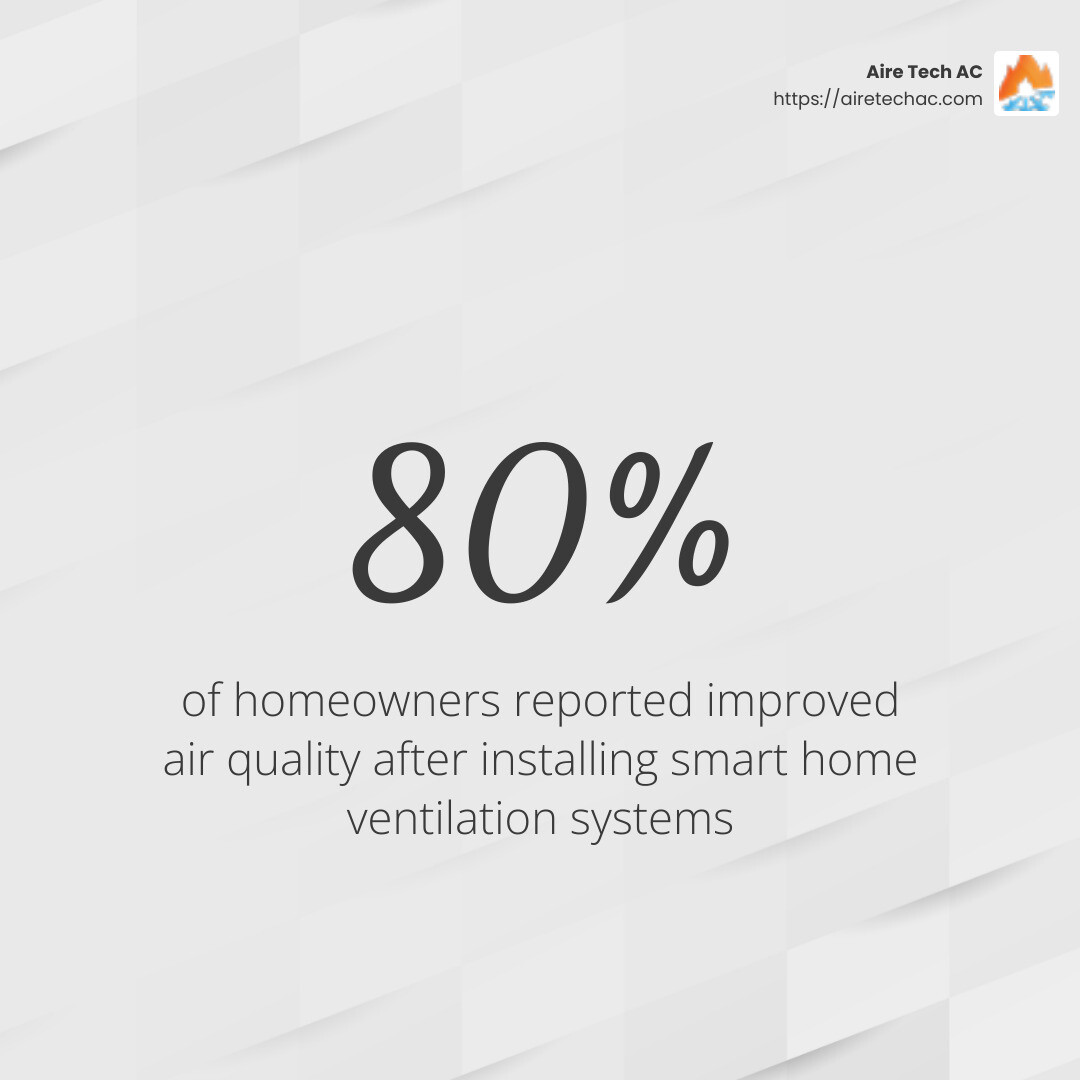
Consider the case of a homeowner who finded dangerously high CO2 levels in their home using an air quality sensor. The sensor revealed that their furnace was venting exhaust indoors, posing a serious health risk. Once the issue was identified, they could take immediate action to fix it. This example shows how crucial good air quality is to your health.
Cost Savings
By optimizing airflow and reducing the need for heating and cooling, smart home ventilation systems can lead to significant cost savings. According to experts, homeowners in the U.S. spend around half of their energy bills on heating and cooling. Smart vents like those from Aire Tech AC can close or partially close when a room is unoccupied, preventing energy wastage.
Improved Comfort
Smart home ventilation systems ensure that every room in your home is kept at the perfect temperature. Systems like the Aire Tech SmartVent allow for room-by-room temperature control, eliminating hot and cold spots. This means you can enjoy consistent comfort throughout your home.
Health Benefits
Maintaining good indoor air quality is essential for your health. Poor ventilation can lead to the buildup of moisture, which can cause mold and mildew. These can trigger allergies and respiratory issues. Systems like Aire Tech SmartVent are designed to reduce excess damp, moisture-filled air, creating a healthier living environment.
In summary, smart home ventilation systems offer numerous benefits, including energy efficiency, improved air quality, cost savings, improved comfort, and health benefits. These systems are an excellent investment for anyone looking to create a healthier and more comfortable living space.
Types of Smart Home Ventilation Systems
When it comes to smart home ventilation, there are several types of systems to consider. Each type has its own method for improving air quality and maintaining a comfortable indoor environment. Here’s a look at the main types:
Whole House Ventilation
Whole house ventilation systems are designed to ventilate the entire home. These systems work by continuously exchanging indoor air with fresh outdoor air. They can be integrated with your HVAC system or operate independently. Whole house systems are ideal for maintaining consistent air quality throughout your home.
Exhaust Systems
Exhaust ventilation systems remove stale air from specific areas like bathrooms and kitchens. These systems use fans to push indoor air out, creating a slight negative pressure that draws in fresh air through leaks and vents. They are simple to install and are effective at removing moisture and odors.
Supply Systems
Supply ventilation systems work by bringing fresh air into your home, creating a positive pressure that pushes stale air out through leaks and vents. These systems are particularly useful in homes with issues like radon or other soil gases. They also help in filtering outdoor air before it enters your home, improving overall air quality.
Balanced Systems
Balanced ventilation systems provide equal amounts of fresh air intake and stale air exhaust, maintaining a neutral pressure inside your home. These systems are often equipped with heat or energy recovery features. For example, the SmartVent Balance system is designed for new builds and low-permeability properties, ensuring energy-efficient ventilation.
Balanced systems are ideal for maintaining indoor air quality without compromising energy efficiency. They are particularly useful in climates with extreme temperatures, as they can pre-condition the incoming air to reduce heating or cooling loads.
Each of these systems offers unique benefits and can be custom to meet the specific needs of your home. Understanding the differences between them can help you make an informed decision when choosing the right smart home ventilation system.
Key Features of Smart Home Ventilation Systems
When choosing a smart home ventilation system, understand the key features that can improve your home’s air quality and comfort. Here are some critical aspects to consider:
Remote Control
One of the standout features of modern ventilation systems is remote control. With the ability to control your system from anywhere using a smartphone app, you can adjust settings to ensure your home is always comfortable. Whether you’re at work or on vacation, you can monitor and manage your ventilation system effortlessly.
Scheduling
Scheduling capabilities allow you to set specific times for your ventilation system to operate. This means you can program the system to ventilate your home when it’s most needed, like during peak humidity times or when you’re typically away. Weekly scheduling options, as seen in systems like the SmartVent Advance, offer flexibility and convenience, ensuring your home stays fresh without manual intervention.
Sensors
Sensors play a crucial role in smart home ventilation systems. These devices continuously monitor temperature, humidity, and air quality. For instance, the SmartVent Positive3 system uses sensors to measure moisture content and adjust ventilation rates accordingly. By leveraging real-time data, these systems can optimize performance and prevent issues like over-ventilation or introducing cold air when it’s not needed.
Integration with Smart Home Devices
Integration with other smart home devices improves the functionality of your ventilation system. Many modern systems can connect with smart thermostats, lighting, and security systems, creating a cohesive and efficient home environment. For example, integrating your ventilation system with a smart thermostat can help balance temperature and air quality, leading to improved comfort and energy savings.
How to Choose the Right Smart Home Ventilation System
Choosing the right smart home ventilation system involves considering several factors to ensure it fits your needs perfectly. Let’s break it down step by step:
Home Size
The size of your home plays a crucial role in selecting a ventilation system. Larger homes may require more advanced systems with higher capacity, while smaller homes can get by with simpler setups.
For instance, the SmartVent Balance system offers options for homes up to 150m² with 3 supply outlets and 1 extract, and for larger homes up to 350m² with 5 supply outlets and 2 extracts. Make sure the system you choose can handle the square footage of your home efficiently.
Budget
Budget is another critical factor. Smart home ventilation systems range in price based on features and capacity.
Entry-level systems like the SmartVent Lite+ for single rooms are more affordable and can be a good starting point. On the other hand, more comprehensive systems like the SmartVent Synergy3 for larger homes come with higher costs but offer advanced features and better efficiency.
Compatibility
Ensure the system is compatible with your existing smart home devices. Integration with devices like smart thermostats, lighting, and security systems can improve overall efficiency and convenience.
For example, systems that work with popular smart thermostats like ecobee or Nest can provide seamless control and better performance. Always check the compatibility list before purchasing to avoid any integration issues.
Installation Requirements
Consider the installation requirements of the system. Some systems are DIY-friendly and can be installed with minimal effort, while others might require professional installation.
- Easy Installation: Systems like the Tempra Through Wall Heat Recovery Fan are designed for simple installation, making them ideal for DIY enthusiasts.
- Professional Installation: More complex systems, like the SmartVent Synergy3, might need professional setup to ensure optimal performance and reliability.
Tip: Always refer to the manufacturer’s guidelines to understand the installation process and determine if you need professional help.
By taking into account these factors—home size, budget, compatibility, and installation requirements—you’ll be better equipped to choose the right smart home ventilation system for your needs. This will ensure a comfortable, healthy, and energy-efficient home environment.
Installation and Maintenance of Smart Home Ventilation Systems
Once you’ve chosen the right smart home ventilation system, the next step is installation and maintenance. Let’s break it down:
Easy Installation
Many smart home ventilation systems are designed for easy installation. For example, the Tempra Through Wall Heat Recovery Fan is a great option for those who prefer a DIY approach. These systems come with clear instructions and require minimal tools.
- Step-by-Step Guides: Most systems provide detailed manuals to guide you through the process.
- Minimal Tools Needed: Basic household tools are usually sufficient.
- Quick Setup: Installation can often be completed within a few hours.
Professional Installation
For more complex systems, professional installation is recommended. Systems like the SmartVent Synergy3 require precise setup to ensure optimal performance.
- Expertise Required: Professional installers have the experience to handle intricate systems.
- Time Efficiency: Professionals can complete the installation faster and more accurately.
- Warranty Protection: Some warranties may only be valid if installed by certified technicians.
Maintenance Tips
Regular maintenance is crucial to keep your smart home ventilation system running efficiently. Here are some simple tips:
- Check Filters: Replace or clean filters regularly to ensure clean air circulation.
- Inspect Vents: Ensure vents are free from obstructions and debris.
- Monitor Sensors: Keep sensors clean and check for proper functionality.
- Software Updates: Regularly update the system software to benefit from the latest features and improvements.
Troubleshooting
Even the best systems can encounter issues. Here are some common problems and their solutions:
- Reduced Airflow: Check for blocked vents or dirty filters. Clean or replace as necessary.
- Sensor Malfunctions: Recalibrate or replace faulty sensors.
- Connectivity Issues: Ensure your system is connected to the Wi-Fi network. Restart the system if needed.
- Unusual Noises: Inspect the system for loose parts or debris. Tighten screws and clean the unit.
Tip: Refer to the user manual for specific troubleshooting steps related to your system.
By following these installation and maintenance tips, you can ensure your smart home ventilation system operates smoothly, providing a comfortable and healthy home environment.
Frequently Asked Questions about Smart Home Ventilation
What are the costs associated with smart home ventilation systems?
Installation Cost
The cost of installing a smart home ventilation system can vary widely based on the complexity of the system and whether you opt for DIY or professional installation. For example:
- DIY Installation: Systems like the Tempra Through Wall Heat Recovery Fan can be installed by homeowners, which saves on labor costs. Expect to spend around $600-$800 for such units.
- Professional Installation: More complex systems like the SmartVent Synergy3 require professional installation. This can add $1,000-$2,000 to the total cost, but ensures optimal performance and warranty protection.
Maintenance Cost
Regular maintenance is essential to keep your system running efficiently. Costs may include:
- Filter Replacements: Budget around $20-$50 annually for replacing or cleaning filters.
- Professional Inspections: Annual inspections by a professional can cost $100-$200 but can prevent costly repairs down the line.
Energy Savings
Investing in a smart home ventilation system can lead to significant energy savings. By optimizing airflow and reducing the need for heating and cooling unoccupied rooms, homeowners can save up to 30% on energy bills. According to some estimates, U.S. homeowners spend around half of their home energy bills on heating and cooling, so these savings can be substantial.
How do smart home ventilation systems improve air quality?
Sensors
Smart home ventilation systems often come equipped with advanced sensors that monitor air quality in real-time. These sensors can detect:
- Carbon Dioxide (CO2) Levels: High CO2 levels can cause drowsiness and headaches. Systems like Airthinx can alert you when levels are too high.
- Volatile Organic Compounds (VOCs): These are harmful chemicals found in household products. Smart sensors can detect and help mitigate their presence.
- Particulate Matter: Systems can measure different sizes of particulate matter, including smoke and dust, ensuring cleaner air.
Air Filtration
Most smart ventilation systems include high-efficiency filters that trap dust, pollen, and other allergens. This significantly improves indoor air quality and can benefit those with allergies or respiratory issues.
Humidity Control
Maintaining proper humidity levels is crucial for comfort and health. Smart systems can:
- Reduce Excess Humidity: Prevent mold and mildew growth by expelling moist, stale air.
- Add Humidity: In dry environments, some systems can add moisture to the air, preventing issues like dry skin and respiratory discomfort.
Can I integrate smart home ventilation with other smart home devices?
Compatibility
Many smart home ventilation systems are designed to integrate seamlessly with other smart home devices. For example, systems like Airthinx can connect with Nest thermostats to optimize air quality and temperature control.
Smart Home Hubs
Using a smart home hub like Amazon Echo or Google Home can centralize control of all your devices. This allows you to:
- Voice Control: Adjust settings using voice commands.
- Automation: Create routines that include your ventilation system, such as turning on when you arrive home.
App Control
Most smart home ventilation systems come with companion apps that offer:
- Real-Time Monitoring: Check air quality and system performance from anywhere.
- Remote Control: Adjust settings, schedule maintenance, and receive alerts directly on your smartphone.
- Integration: Sync with other smart home apps for a unified experience.
By integrating your smart home ventilation system with other devices, you can create a more efficient and comfortable living environment.
Call Aire Tech Today!
At Aire Tech AC, we understand the importance of maintaining a comfortable and healthy home environment. Our team of experts is dedicated to providing top-notch HVAC services, including smart home ventilation systems. We are based in Perris, CA, and have built a reputation for excellence in customer service and HVAC expertise.
Our Commitment to Customer Service
We believe that great customer service is the foundation of our business. Our team is always ready to assist you with any questions or concerns you may have about your smart home ventilation system. Whether you need help choosing the right system, scheduling an installation, or troubleshooting an issue, we are here to support you every step of the way.
HVAC Expertise
With years of experience in the HVAC industry, our technicians are well-versed in the latest technologies and best practices. We are committed to staying up-to-date with industry advancements to ensure that we provide you with the most efficient and effective solutions for your home.
Serving Perris, CA, and Beyond
Located in Perris, CA, we proudly serve the surrounding areas, providing high-quality HVAC services to our community. We take pride in our work and strive to exceed our customers’ expectations with every job we undertake.
Why Choose Aire Tech AC?
- Expert Installations: Our professional installations ensure that your system operates at peak performance.
- Reliable Maintenance: Regular maintenance by our skilled technicians keeps your system running smoothly and efficiently.
- Customer Satisfaction: We prioritize your comfort and satisfaction, offering personalized solutions custom to your needs.
Choosing Aire Tech AC means choosing a partner dedicated to enhancing the comfort and air quality of your home. Contact us today to learn more about our smart home ventilation systems and how we can help you create a healthier living environment.
For more information, visit our website. We look forward to serving you!

